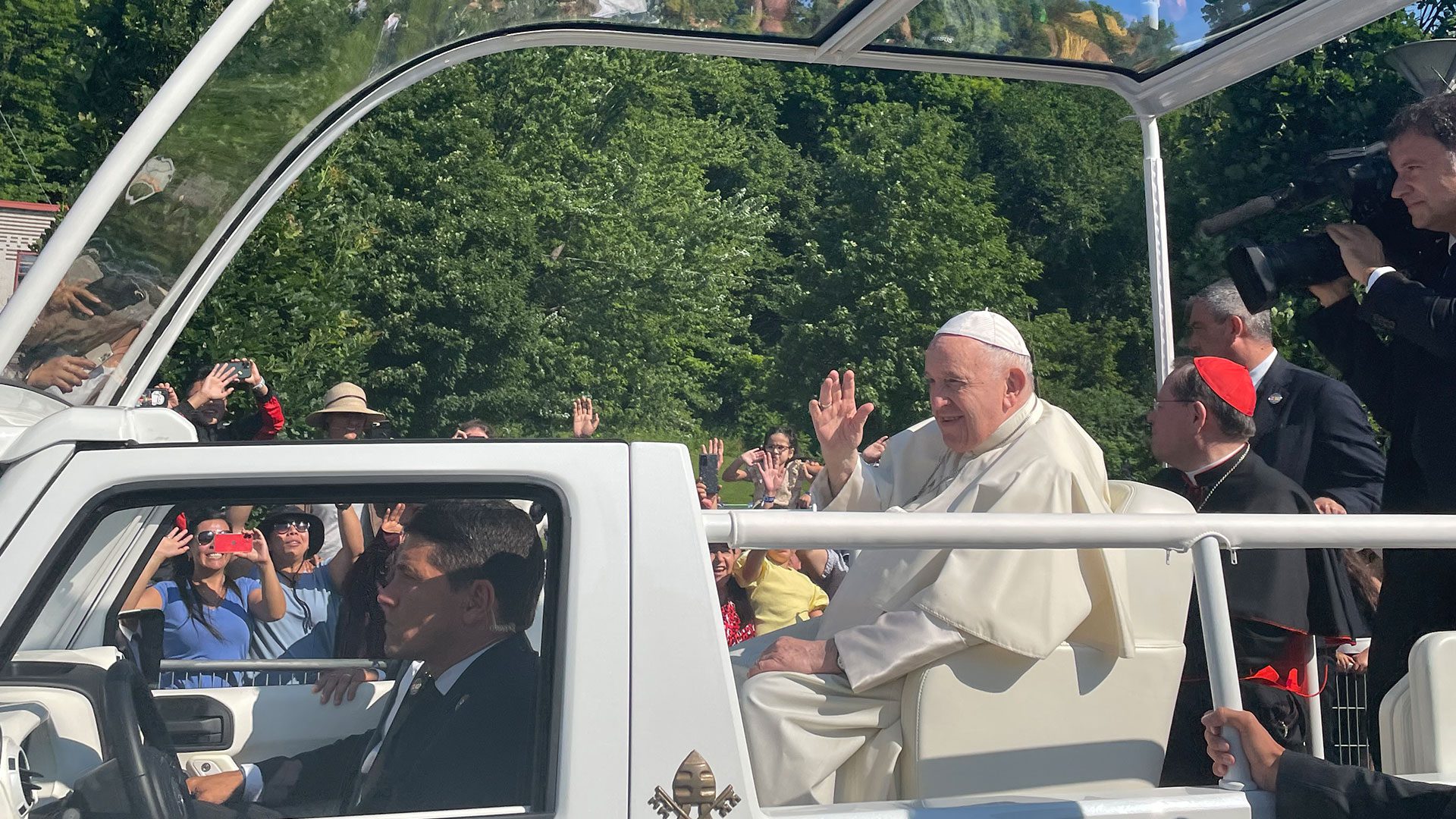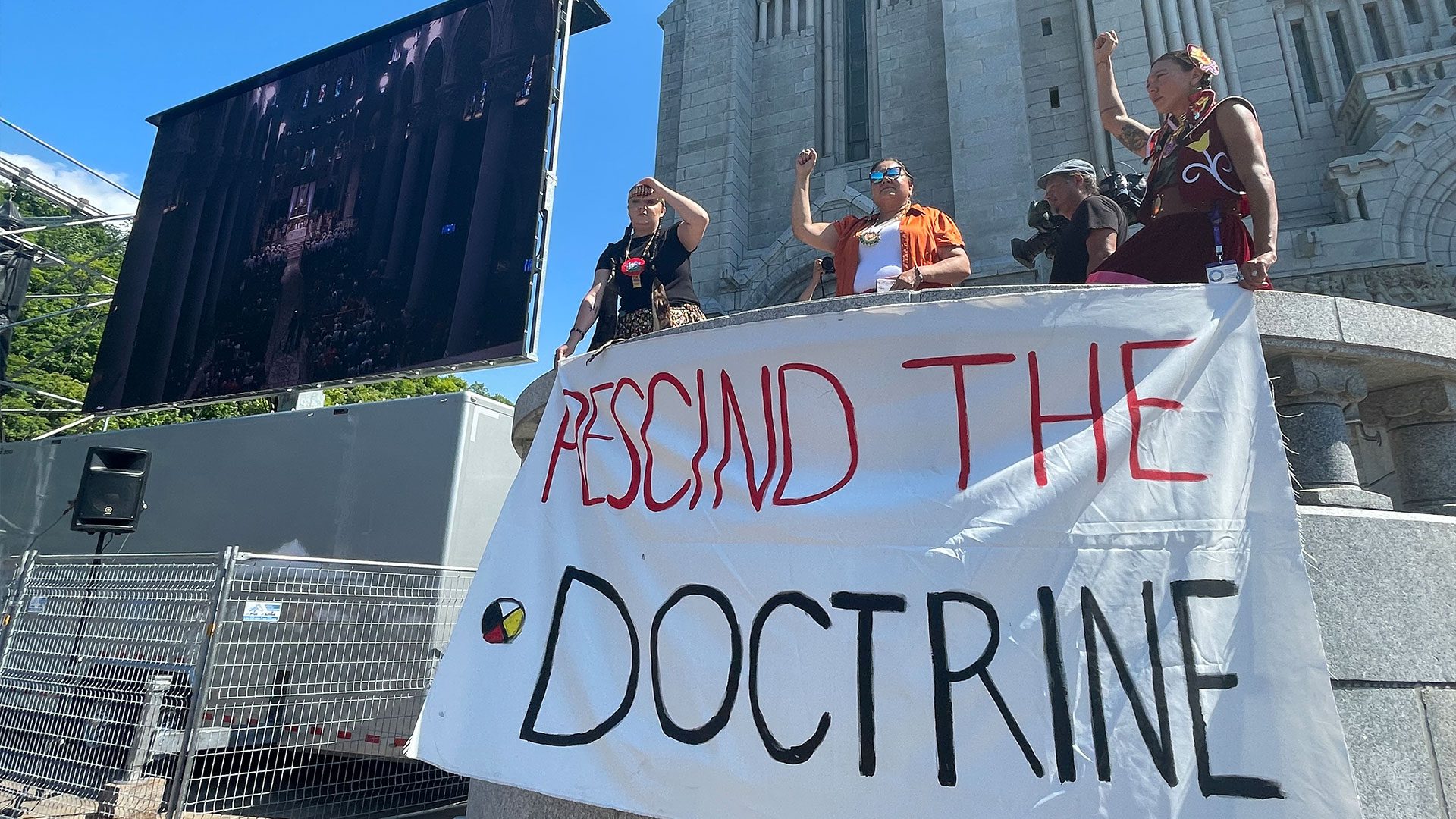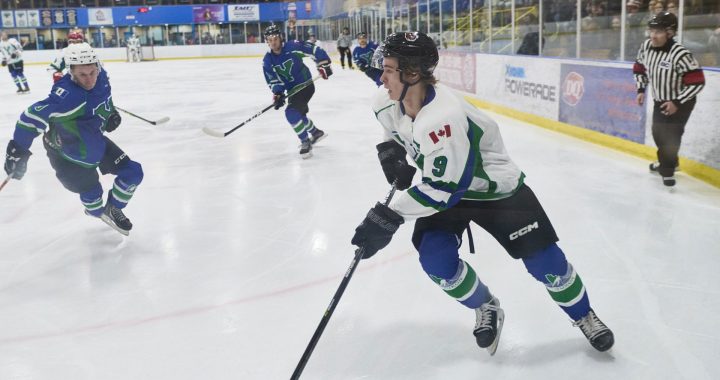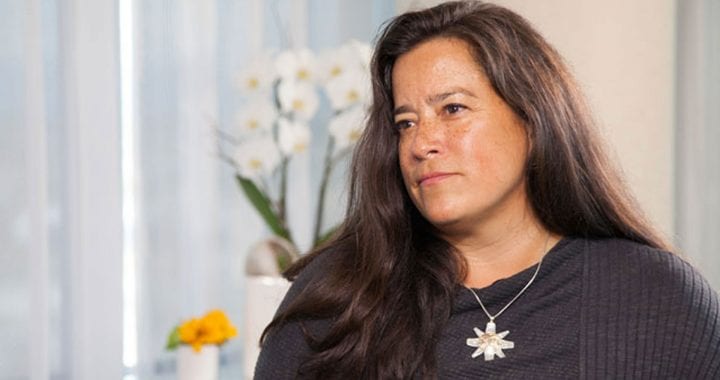For more than 20 years, Marilyn Simon-Ingram, a survivor of the Shubenacadie Indian Residential School in Nova Scotia, has pushed for reparations and acknowledgement from Church and government officials.
After the highly-anticipated mass delivered by Pope Francis, the 68-year-old Simon-Ingram told APTN News she wasn’t sure her two-decade fight was worth it.
“When we got here today, it wasn’t the way we pictured it,” Simon-Ingram said outside Ste. Anne de Beaupré Basilica where the mass was delivered.
“The Pope is here – yes, federal government’s here – yes, provincial government is here, yes – but the survivors are pushed away in different areas, and it’s no longer about the survivors anymore.
“It’s not about the residential school and the damage they’ve done to us and our children. It’s about them.”
Inside Ste Anne de Beaupré, hundreds of residential school survivors came together for mass.
Simon-Ingram, from the Mi’kmaq community of Elsipogtog, said she was looking forward to connecting with survivors and some healing when she decided to attend the mass.
She said she didn’t get either of those things.
“It was all backwards. Look around right now. The majority of the survivors are outside the fence,” she said, pointing to the fence that surrounded the basilica.
Despite being sick, she travelled 700 km hoping to find solace or relief.
“The politicians and wealthy people in the room, you could see they were taking up a lot of the space and the best seats. Survivors could not congregate together. They wanted to be together. We got a lot of support from each other all these years, and here, now, it isn’t happening,” she said.
Preparing for the Pope’s visit

Indigenous groups have been preparing for the Pope’s arrival for more than a week — holding solidarity marches, and attending Indigenous-centred Catholic masses held near Quebec City.
On Tuesday, before the Pope’s arrival, hundreds of Innu and Atikamekw community members from across Quebec – and as far as Labrador – made their way to the Basilica for Ste. Anne’s Feast, also known as the First Nations Mass.
While it normally marks the end of a nine-day pilgrimage of prayer, this year, the Ste. Anne’s Feast marked the beginning of the Pope’s three-day visit to Quebec.
Before the arrival, however, leaders like Ghislain Picard, regional chief of the Assembly of First Nations Quebec-Labrador, stressed the need for the Pope to repeat the apology he made to survivors gathered on Maskwacis in Treaty 6 earlier in the week.
“I guess in my wildest thoughts – I was hoping for the pope to just stay away from the protocol. You know, toss his written speech, and speak from the heart,” Picard explained.
Read More:
Road to Truth: The Pope’s Visit
Shortly after touching down in Quebec, Pope Francis reiterated his apologies in a formal address – accompanied by Prime Minister Justin Trudeau and Governor General Mary May Simon.
In his address, the conceded again that “many Christians” were responsible for the harm done to Indigenous Peoples through Catholic-run residential schools and colonialism.
He also said the apologies were only a “first step” in the journey towards healing and announced that an investigation should be undertaken to assess the extent of the damage done by the Catholic Church.
Some people gathered at the basilica on Thursday had ideas about possible next steps.
As the Pope began delivering his mass, cousins Sarain Fox and Chelsea Brunell unfurled a banner from the top staircase reading, “Rescind the Doctrine,” referring to the Doctrine of Discovery.
This demand has echoed through survivors, marchers, and First Nations chiefs over the course of the papal apologies.
“We need to talk about the doctrine of discovery and how it essentially makes Indigenous people not human, soulless, and therefore have no rights to our land, our ceremony, and our culture – and we know that’s not true, More than an apology, we need action. And part of that action is truth,” said Fox.

On Thursday night, Grand Chief of the Cree Nation Mandy Gull-Masty will join First Nations leaders from across the country at a dinner hosted by Canadian bishops.
According to documents obtained by APTN, the Doctrine of Discovery, along with Church records and other urgent issues will be disussed.
“We’re looking for information. First and foremost, we’re looking for the school records, we’re looking for access to information, we’re looking to work closely with the local diocese,” Gull-Masty said.
“What I’m seeing from the pope is that he’s really setting the tone on how he expects the conference of Canadian Catholic Bishops to work with indigenous groups here in Canada.”
The view from the media pen. @APTNNews pic.twitter.com/3qOspiiERn
— Emelia Fournier (@emelia_fournier) July 28, 2022
But the process is arduous for many.
Speaking to a seasoned counsellor, APTN learned that the number of calls made to the national residential school crisis line has reached “overwhelming” levels since the Pope’s arrival in Canada.
Indigenous Services Canada coordinated support tents at the Plains of Abraham in Quebec City, where experienced Indigenous support workers from across the province were ready to help those dealing with the trauma the visit is bringing.
“We’re here for the people [when] something triggers their trauma. The trauma that they live, it’s in different levels,” said Donna Larivière, an Anishinaabe support worker present at the tent.
“There’s some they had more bad experiences than others, but us, there’s no difference. We’re there for them. We’re here to listen,”
Support workers were also present on the grounds of the basilica, ready to help and offer smudging and emotional counsel.
Simon-Ingram, along with many survivors, is reliving the trauma as discussions about intergenerational trauma – and the impact of the residential school’s legacy – continue to play out.
“The price is for the children. It’s going to cost them – and I’d hate to see that happen. Unless all you [leaders] step up,” Simon-Ingram added.
“I tell the youth, fight, learn, move on, teach, protect, because we [survivors] can’t anymore.”










